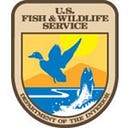Birds of a Feather: One Ranger’s Foray Into Falconry
I am standing in the middle of the desert, staring at the sky. Having been perched on a gloved hand just moments ago, the red-tailed hawk has now soared on a thermal current to almost 1,000 feet above us. Distracted, I watch as the raptor hovers and glides with those invisible air currents, envying its freedom in the nearly cloudless sky. The winds have only just died down enough for the bird to fly safely. Back on the ground, my instructors are quick to refocus my attention to the task at hand. Our mission: hunting jackrabbits.
My role in this exercise is simple. I will be moving through the dense thicket of saltbush, creosote, and mesquite, kicking stems and rustling limbs in order to flush out our quarry. The work is not without risk, though. No trails exist, so I must constantly dodge thorns, loose rock, and plenty of broken glass & metal — typical hazards one expects to find in any patch of neglected desert. I am thankful that the weather is still cool enough that I do not need to worry about rattlesnakes. While our team disperses and disturbs the vegetation, the raptor sits perched on a Joshua tree, waiting for a sign of prey.
Red-tailed hawks are sometimes used in falconry. Photo courtesy of Maud Sýrr
Using hawks (or other falconry birds) to hunt prey, or “hawking” as it is more commonly referred to, is an ancient tradition tracing back some 4,000 years. The practice was introduced to Europe from Asia and has historically been a status symbol among nobles of Europe, the Middle East, and Mongolia. While the sport has certainly evolved since then, it is still not a hobby one can pick up on a whim. Falconry is a serious commitment. While laws and regulations about hunting and falconry vary from state to state, all new practitioners are required to complete a two-year apprenticeship supervised by a licensed sponsor.
When hunting, it is important for the falconer to have a relationship with the bird. The bird must recognize that it is part of a team so that it does not fly off and self-hunt. If a bird flies away from the falconer and catches game, the bird does not learn that the falconer was part of the equation. Therefore, when the falconer flushes game and makes noise to alert the bird, the animal associates the falconer with the appearance of game. Similarly, when game is caught and the falconer provides a food reward to the bird, it reinforces both the behavior and the relationship.
Searching for prey. Photo: Joshua Contois/USFWS
Suddenly, a flash of brown and white tears from beneath my feet and down a wash. Almost overcome by the surprise, I begin shouting and clapping my hands, signaling the red-tailed hawk to take flight and pursue. Jackrabbits are natural survivors. They exploit the bird’s reliance on movement-attuned vision by running towards a bush and freezing once the hawk is close. Half of the time, this causes the bird to lose momentum, become distracted, or even crash, at which point the rabbit runs away. This time, though, our team maintains a barrage of shouting and clapping to assist the hawk as we trail behind. The hawk has sighted its quarry and dives after it. In an instant, the chase is over. The red-tailed hawk sits atop its prey, which now lies motionless on the desert floor.
It’s important to develop a relationship with your bird. Photo: USFWS
On our hike back to the truck, I contemplate on the relationship between predator and prey. My instructors tell me there are plenty of days when they leave empty-handed. Regardless, I am glad that my first hunt was a successful one. Nothing in this kill will go to waste. A single jackrabbit can feed a red-tailed hawk for almost two weeks. More than just the thrill of the hunt, this experience taught me a lot about animal behavior, raptor conservation, and what it means to responsibly harvest wildlife. I am thrilled to have had this opportunity and hope to repeat it again soon. Falconry is an expansive, fascinating sport that I have just begun to explore. I expect that in the future it will lead me down more than one proverbial rabbit hole.
Thanks to Dave Kanellis, Civon Gewelber, & Maud Sýrr for their instruction & support.
By Joshua Contois, Park Ranger, Desert National Wildlife Refuge Complex.
